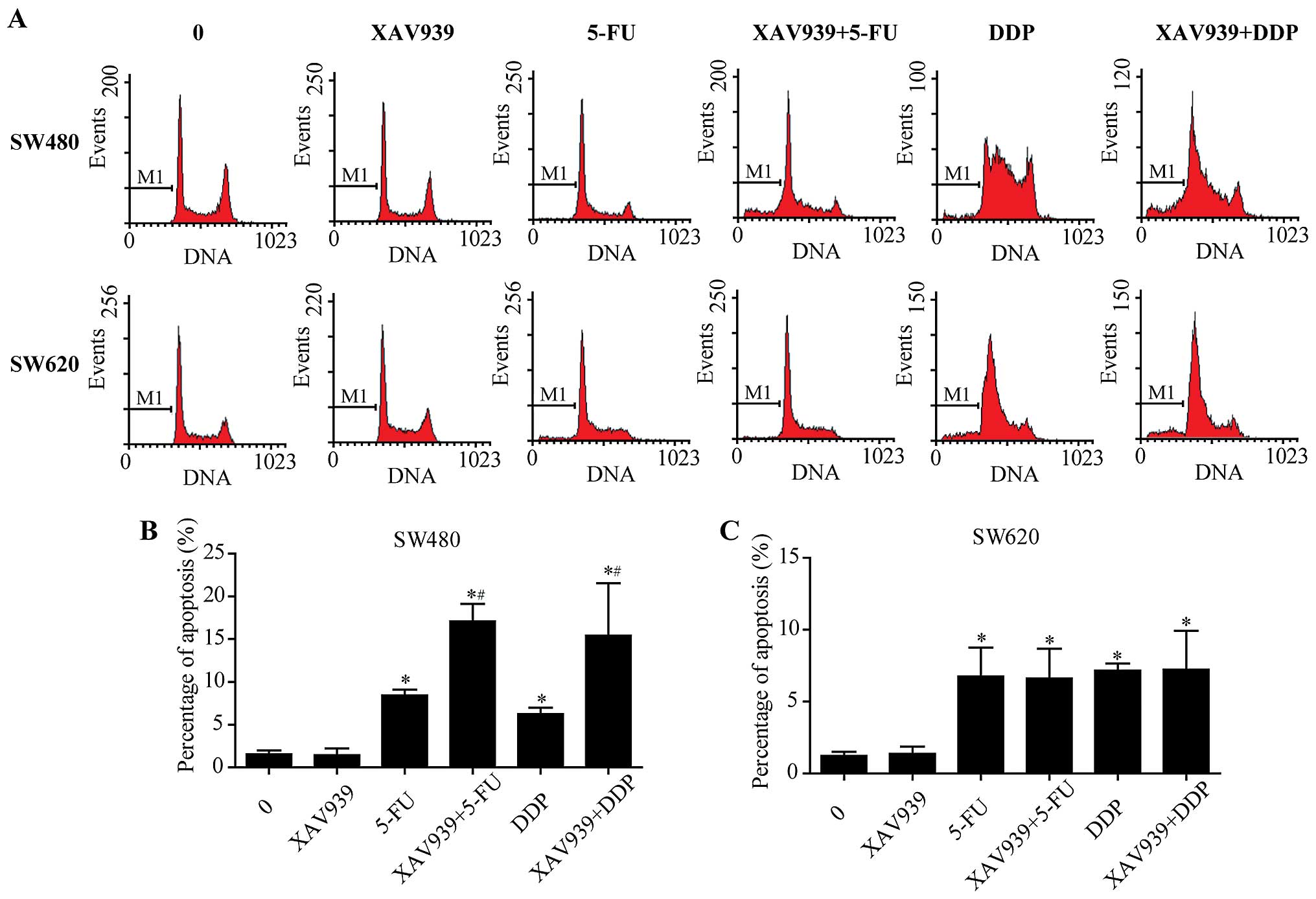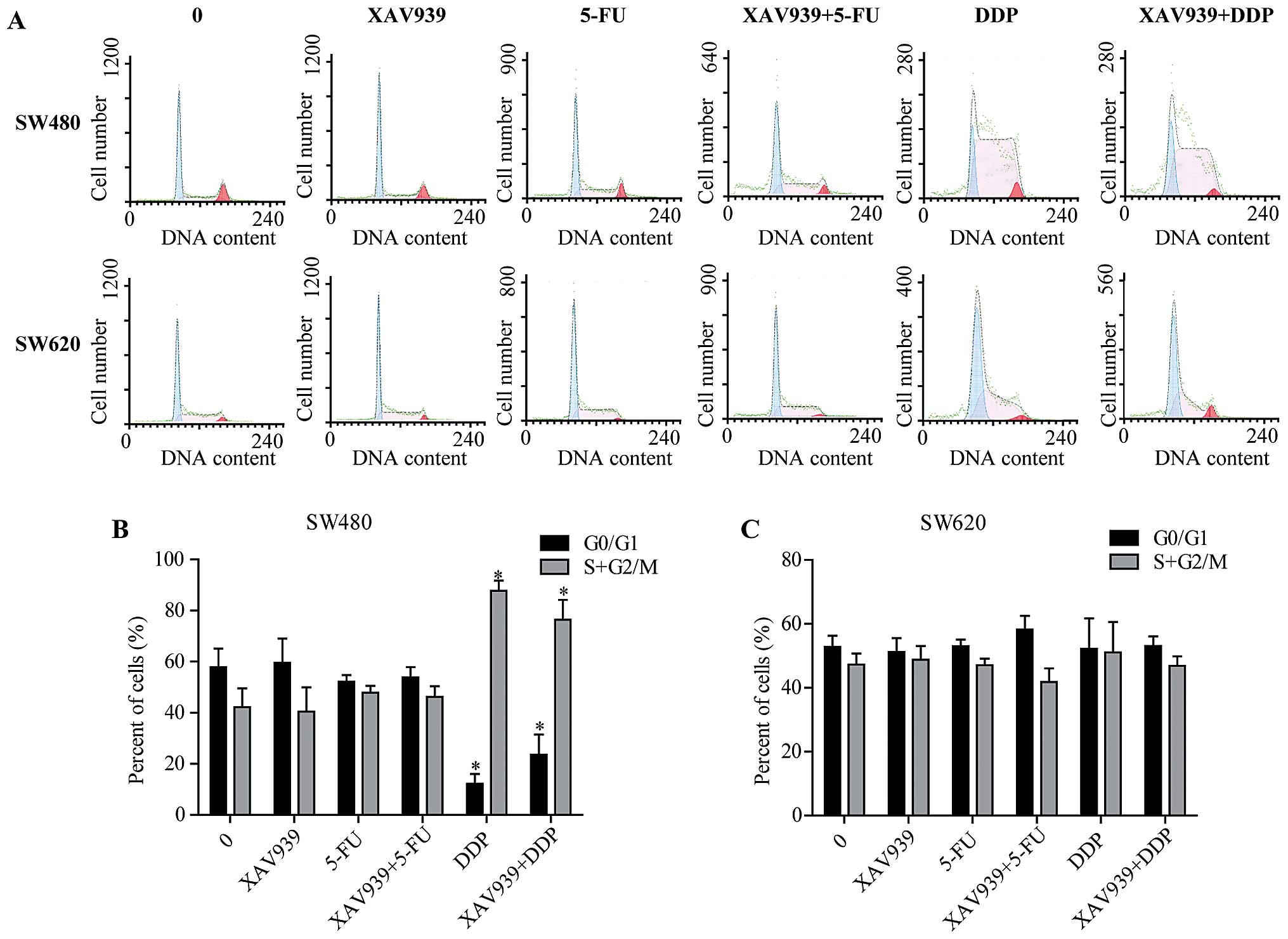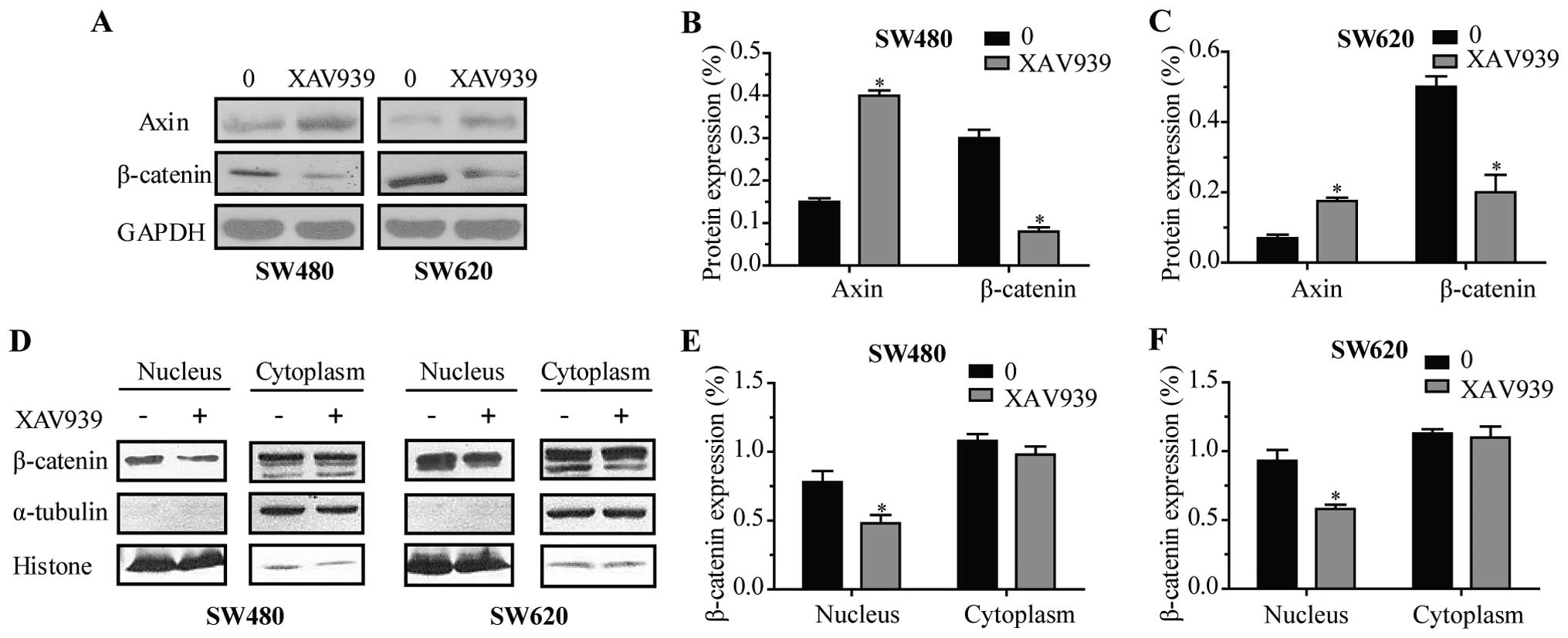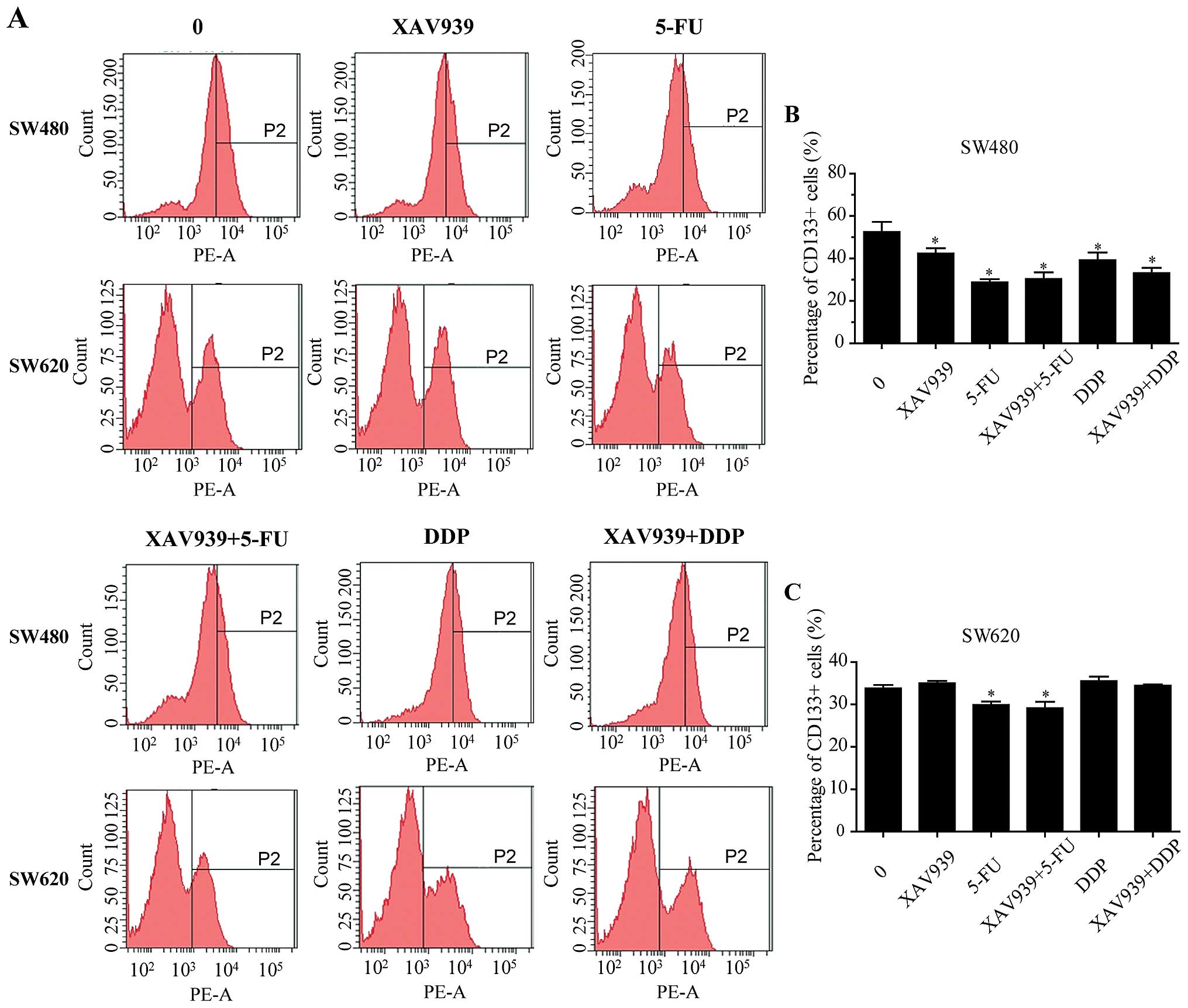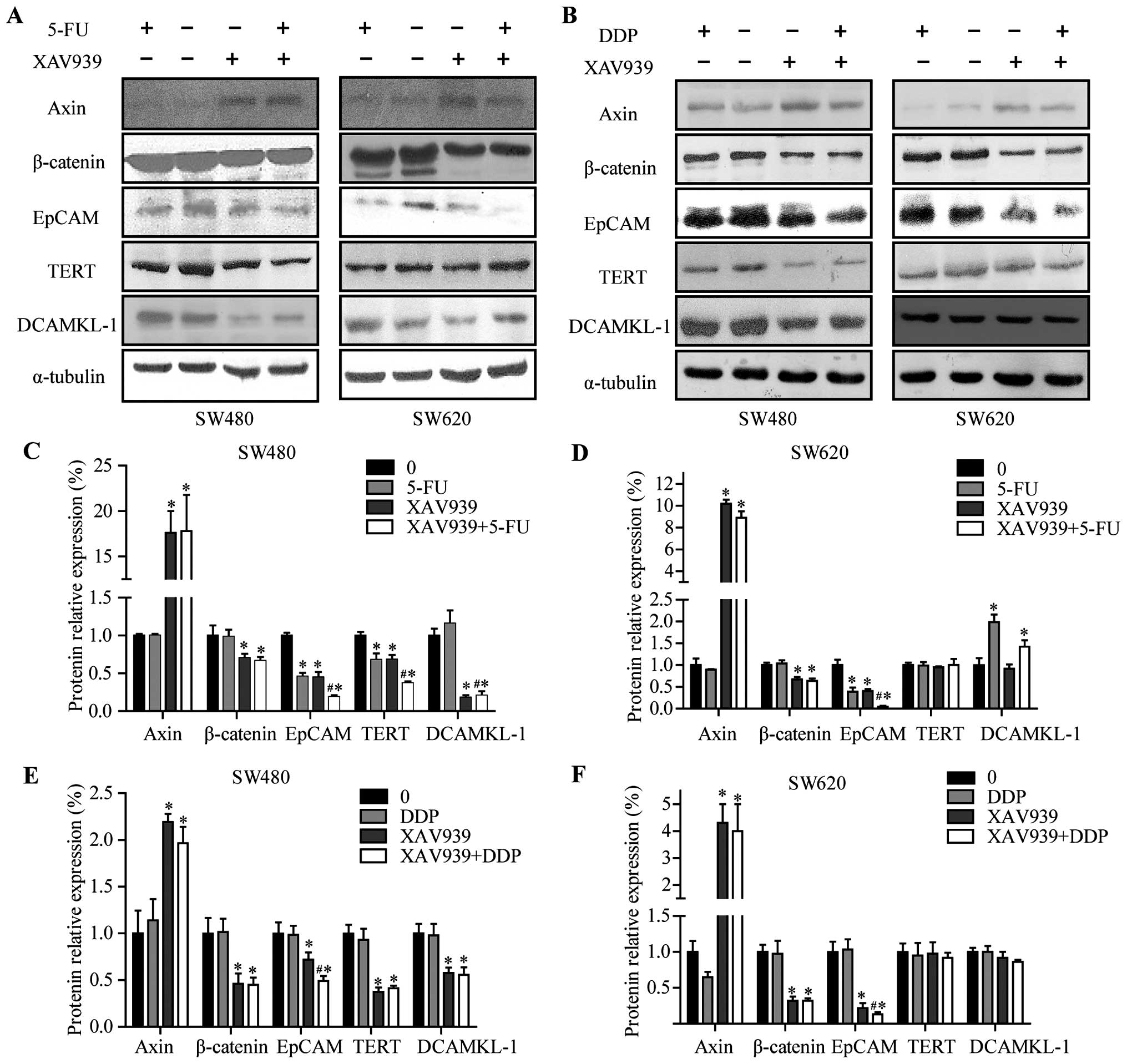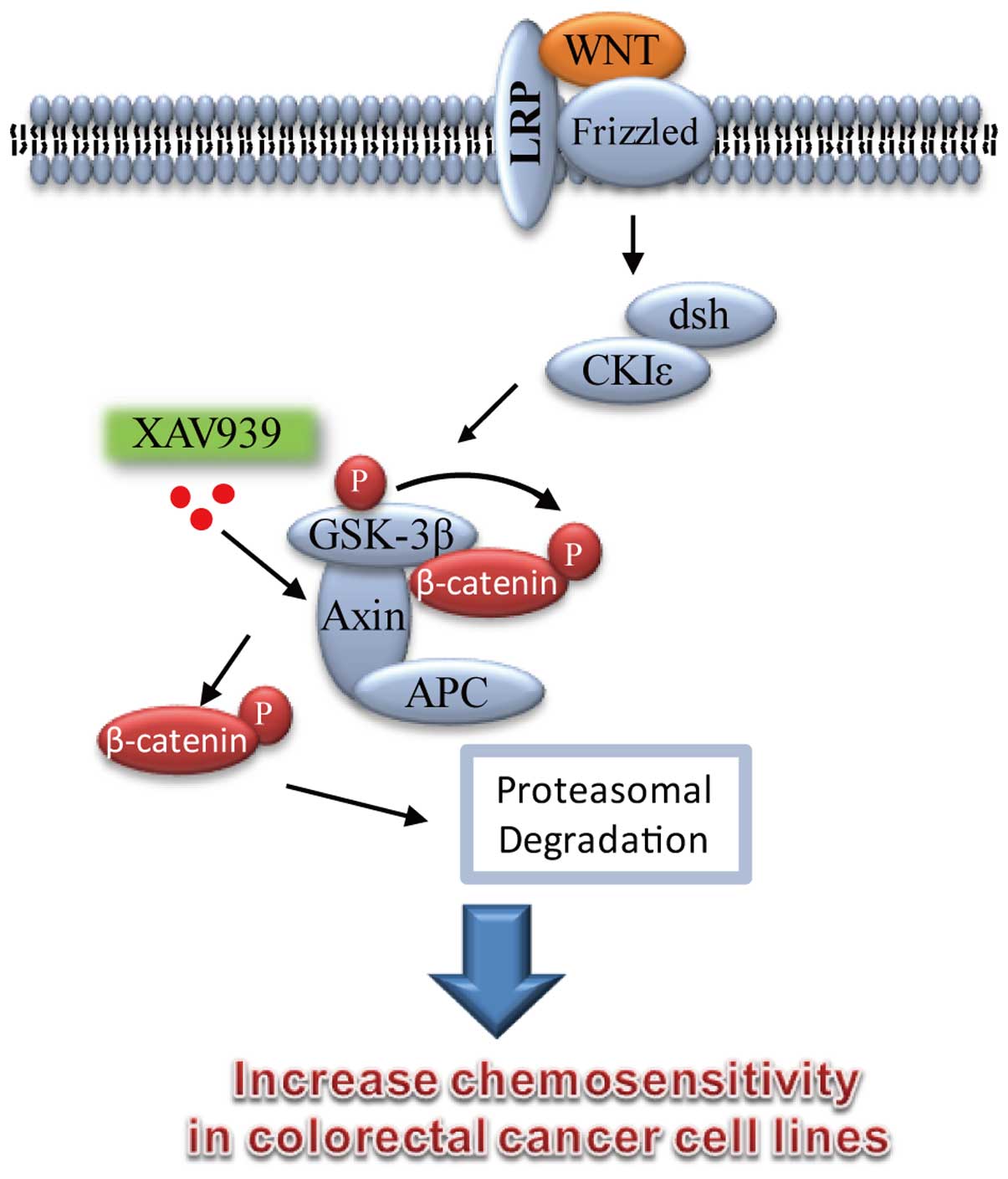Tankyrase 1 inhibitior XAV939 increases chemosensitivity in colon cancer cell lines via inhibition of the Wnt signaling pathway
- Authors:
- Published online on: January 26, 2016 https://doi.org/10.3892/ijo.2016.3360
- Pages: 1333-1340
-
Copyright: © Wu et al. This is an open access article distributed under the terms of Creative Commons Attribution License.
Abstract
Introduction
Colorectal cancer (CRC) is the second most commonly diagnosed cancer in females and the third in males (1). 5-Fluorouracil (5-FU) and cisplatin (DDP) are commonly used in the chemotherapy of CRC, but typical patient response rates for treatment with those anticancer agents are between 10% and 30%, allowing cancer progression (2).
Current evidence suggests the drug resistance and treatment failure are due to properties of tumor cells called cancer stem cells (CSCs) (3). Only small populations of tumor cells are CSCs within a tumor, and responsible for the initiation, growth, and development of tumor, pending on the animal model (4–6). Similar to somatic tissue stem cells, CSCs proliferate slowly, they are in dormant or slow-growing phase of the cell cycle. This partially accounts for their therapeutic refractoriness to chemo/radiation therapy and tumor relapse (7).
WNT proteins are a family of secreted, glycosylated, and palmitoylated peptides that mediate a wide variety of processes during embryogenesis by regulating stem cell division, migration, and integrity of the stem cell niche (8,9). Accumulating evidence indicates a critical role of Wnt, Notch, Shh and Bmi-1 signaling pathway in the self-renewal and drug resistance of CSCs (5). Aberrant Wnt signaling pathway is associated with a wide array of tumor types and plays an important role in the maintenance of stemness of CSCs (5,10). Research over the last decade has shown that cells harbor loss-of-function mutations involving components of the Wnt signaling cascade, such as APC, β-catenin and Axin, are considered universal in CRC (11–13). The mutations cause aberrant transcriptional induction of Wnt/β-catenin target genes (14,15).
Recent studies indicated that XAV939 is a small molecule inhibitor of WNT signaling pathway, it broke Wnt signaling pathway in cancer cell lines through binding to tankyrase (TNKS) catalytic poly-ADP-ribose polymerase (PARP) domain, and then resulted in marked stabilization of the Axin protein, finally leading to increased β-catenin destruction (16–18).
Therefore, the aim of the present study was to investigate the mechanisms and effects of WNT/β-catenin pathway on drug resistance in CRC. In the present study, the colon cancer cells SW480 and SW620 were treated with XAV939 for 24 h, the CD133 positive cell population, apoptosis and cell cycle of these cells were detected by flow cytometry. The β-catenin, Axin and CSC-related molecules were detected by western blotting. Our results suggest that the WNT pathway small molecule modulator XAV939 affected apoptosis induced by 5-FU/DDP, accompanied by the protein expression level alteration of β-catenin, Axin and CSC markers in colon cancer cells.
Materials and methods
Chemicals
XAV939 was purchased from Sigma (St. Louis, MO, USA), and 5-FU was from Shanghai Xudong Haipu Pharmaceutical Co., Ltd. (Shanghai, China). DDP was purchased from Yunnan Biovalley Dengzhanhua Pharmaceutical Co., Ltd (China).
Cell culture
Human colon adenocarcinoma SW480 and SW620 cells were obtained from American Type Culture Collection. The cells were cultured in RPMI-1640 medium (Gibco, Grand Island, NY, USA) with 10% fetal bovine serum (TBD, China) at 37°C under an atmosphere of 5% CO2.
Cell cycle and apoptosis analysis
Following treatment with different drugs for 24 h, the cells were harvested and fixed in 70% ice-cold ethanol at 4°C for 30 min. After washing with PBS, the cells were incubated with propidium iodide staining buffer (BD Pharmingen, San Diego, CA, USA) for 15 min and analyzed by FACSAria flow cytometer. The experiment was performed in triplicate.
For apoptosis analysis, the cells were treated for 24 h with XAV939 (8 μmol/l), 5-FU (50 μmol/l), XAV939 (8 μmol/l) + 5-FU (50 μmol/l), DDP (8 μmol/l) and XAV939 (8 μmol/l) + DDP (8 μmol/l), separately. The cells were measured using FACSAria flow cytometer (BD Biosciences, USA), and Annexin V (+) cells were counted for apoptotic cells after Annexin V-fluorescein isothiocyanate/propidium iodide (FITC/PI) (BD Pharmingen) double staining. The experiment was performed in triplicate.
Flow cytometry analysis of CD133-positive cell population
Human colon adenocarcinoma SW480 and SW620 cell lines (1×106) were detached by treatment with 0.25% trypsin/EDTA and washed twice with phosphate-buffered saline. The cells were then resuspended in 100 μl of Staining Buffer containing 1% fetal bovine serum and place on ice for 20 min to block Fc receptors. After incubating with primary phycoerythrin anti-human CD133 antibody (Milteny Biotec, Bergisch Gladbach, Germany) for another 10 min on ice in the dark, the cells were washed twice with 1 ml of ice-cold Staining Buffer and centrifuged (300 × g) for 10 min at 4°C. Cells resuspended in 0.3 ml of 2% formaldehyde fixation buffer were analyzed using a FACSAria flow cytometer and Cell Quest software (BD Biosciences). All flow cytometry results were obtained from two independent experiments performed in triplicate.
Western blot analysis
Following treatment with different drugs for 24 h, the cells were collected and lysed. Protein content was measured by the BCA protein assay kit (Beyotime Institute of Biotechnology, Shanghai, China) and 20 μg protein per lane was separated by 8–12% sodium dodecyl sulfate polyacrylamide gel electrophoresis (SDS-PAGE) and transferred onto nitrocellulose membranes. Specific protein bands were achieved with an ECL detection reagent (Pierce, Rockford, IL, USA). Anti-axin (Cell Signaling Technology, Danvers, MA, USA) dilution was 1:500. Anti-β-catenin (Cell Signaling Technology) dilutions were 1:1,000. Anti-DCAMKL-1 and anti-TERT (Abcam, Cambridge, MA, USA) dilutions were 1:300 and 1:800. Anti-EpCAM and anti-α-tubulin (Cell Signaling Technology) dilutions were 1:500 and 1:1,000. Horseradish peroxidase (HRP)-conjugated goat anti-rabbit and goat anti-mouse IgqudG antibodies (ProteinTech Group, Chicago, IL, USA) dilutions were 1:3,000. α-tubulin was used as a protein loading control. The images were captured with ChemiDocTM CRS+ Molecular Imager (Bio-Rad, Hercules, CA, USA). The density of the protein band was quantitated using Quantity One software (Bio-Rad). The experiment was performed in triplicate.
Statistical analysis
Statistical analysis was performed with the SPSS13.0 software package (SPSS Inc., Chicago, IL, USA). Data are presented as mean ± SD. One way analysis of variance (ANOVA) was used for apoptosis, cell cycle and western blot data analyses. P<0.05 was considered to indicate a statistically significant difference.
Results
Effect of XAV939 on apoptosis induced by 5-FU/DDP in SW480 and SW620 cells
After incubation with either control/5-FU/DDP alone or combined with XAV939, the effect of XAV939 on the apoptosis induced by 5-FU/DDP of SW480 and SW620 cells was examined using flow cytometry after Annexin V-FITC/PI staining (Fig. 1A). We found that XAV939 significantly increased apoptosis induced by 5-FU/DDP (Fig. 1B, P<0.05), whereas the effects were slight in SW620 cells (Fig. 1C, P>0.05).
Effect of XAV939 on cell cycle progression induced by 5-FU/DDP in SW480 and SW620 cells
Consistently, after either incubated with control/5-FU/DDP alone or combining with XAV939, SW480 and SW620 cells were stained and cell cycle distribution was determined by flow cytometry (Fig. 2A). In SW480 cells, the percentage of G0/G1 phase cells were decreased, while the percentage of cells at S+G2/M phase of the cell cycle was increased after incubated with DDP (Fig. 2B, P<0.05). However, these effects were not observed in SW620 cells (Fig. 2C, P<0.05).
In addition, there was no significant difference in the cell cycle distribution of SW480 cells between treated with XAV939-DDP and DDP alone (Fig. 2B, P>0.05), and no significant difference was found in the cell cycle distribution of SW480 and SW620 cell treatments with or without XAV939 (Fig. 2B and C, P>0.05). Collectively, these results suggest that XAV939 has no effect on cell cycle distribution.
Effect of XAV939 on proteins involved in WNT/β-catenin signaling pathway
To further investigate the effect of XAV939 on proteins involved in WNT/β-catenin signaling pathway expression, total protein lysates were prepared and analyzed by western blotting. As shown in Fig. 3A, following 24 h of treatment of XAV939, the expression levels of Axin were elevated, while the levels of total β-catenin decreased in SW480 (Fig. 3B, P<0.05) and SW620 cells (Fig. 3C, P<0.05), respectively. Western blot analysis of β-catenin proteins both cytoplasmic and nuclear (Fig. 3D) displayed that β-catenin was downregulated in the nuclei of SW480 (Fig. 3E, P<0.05) and SW620 cells (Fig. 3F, P<0.05) after treatment with XAV939 for 24 h, respectively.
Effect of XAV939 on CD133+ SW480 and SW620 cells
After either treated with 5-FU/DDP alone or combined with XAV939 for 24 h, the effect of XAV939 on the proportion of CD133+ SW480 and SW620 cells was examined using flow cytometry (Fig. 4A). As shown in Fig. 4B and C, the proportions of CD133+ SW480 cells were decreased when either XAV939, 5-FU or DDP was added (P<0.05). There was no significant difference in the proportions of CD133+ SW480 cells between treated with 5-FU/DDP alone and combining with XAV939 (Fig. 4B, P>0.05). In SW620 cells, either treated with 5-FU alone or combined with XAV939 for 24 h, the proportions of CD133+ cells were decreased compared with control (Fig. 4C, P<0.05), but there was no significant difference between the two groups. In addition, either treated with DDP alone or combining with XAV939 had no effect on the proportions of CD133+ SW620 cells (Fig. 4C, P>0.05).
Effect of XAV939 on proteins involved in CSC markers in SW480 and SW620 cells
To further investigate the effect of XAV939 on proteins involved in CSC marker expression, total protein lysates were prepared and analyzed by western blotting (Fig. 5A and B). As shown in Fig. 5C–F, following 24-h treatment of XAV939, the expression levels of Axin were elevated, and the levels of total β-catenin were decreased in SW480 and SW620 cells (P<0.05), respectively, whereas the effects were slight in 5-FU/DDP treated cells (P>0.05). The treatment of SW480 and SW620 cells with XAV939 or 5-FU for 24 h resulted in downregulation in the levels of EpCAM protein (P<0.05), whereas these effects were slight in DDP treated cells (P>0.05). Following 24 h of treatment combining 5-FU/DDP with XAV939 resulted in significantly lower expression levels of EpCAM protein compared with treatment either with 5-FU, XAV939 or DDP alone (P<0.05).
Following 24-h treatment of SW480 cells with XAV939 or 5-FU resulted in downregulation in the levels of TERT protein (Fig. 5C and E, P<0.05). The treatment combining 5-FU with XAV939 resulted in significantly lower expression levels of TERT protein compared with treated either 5-FU or XAV939 alone (Fig. 5C, P<0.05) in SW480 cells. However, these effects were slight in both SW620 and DDP treated cells (Fig. 5D and 5F, P>0.05). Finally, following 24-h treatment with XAV939, the expression levels of DCAMKL-1 were decreased in SW480 cells (Fig. 5C and E, P<0.05). The treatment combining 5-FU with XAV939 resulted in significantly lower expression levels of DCAMKL-1 protein compared with treatment with 5-FU alone (Fig. 5C, P<0.05) in SW480 cells.
Discussion
Intensive study of the Wnt signaling pathway shows accumulating evidence suggesting that activation of WNT signaling pathway in CSCs contribute to their chemoresistance. Therefore, targeting WNT signaling pathway to reverse CSC multidrug resistance in CRC cells is a promising way for improving chemotherapeutic effects (19–22).
The β-catenin destruction complex, which consists of Apc, Axin, Ck1, and GSK-3β, promotes proteasome-mediated proteolysis of phosphorylated β-catenin (23). Axin is a negative regulator of the Wnt signaling pathway, which promotes the phosphorylation and degradation of β-catenin. XAV939, a small molecule inhibitor of WNT signaling pathway was able to block Wnt signaling through stabilizing Axin protein and increasing β-catenin destruction in colon cancer cell lines (16–18). Our results showed that the expression levels of Axin protein were elevated while the levels of total and nuclei β-catenin protein were decreased in SW480 and SW620 cells after treatment with XAV939, and suggested that XAV939 stabilized the Axin protein, finally leading to decreasing nuclear accumulation of β-catenin and improving β-catenin destruction, which is consistent with the results of Renna et al (24) and Bao et al (25).
Consistent with our results, Li et al revealed that HOTAIR induced cisplatin resistance by activating the WNT/β-catenin pathway, which could be reversed by pre-treatment with the inhibitor XAV939 in human ovarian cancer (26). Although no significant difference was found in the apoptosis ratio of CRC cells after treatment with XAV939, combined XAV939 with 5-FU or DDP could significantly enhance the apoptosis ratio of CRC cells, suggested that XAV939 increases the sensitivity of tumors to chemotherapy. Renna et al (24) also reported that statistically significant difference in mortality rate was not detected between XAV939 treated cells and DMSO control cells, but the co-administration of XAV939 and ionizing radiation (IR) inhibited MB cells proliferation and clonogenic capacity, decreased their efficacy in repairing DNA damage, and increased IR-induced cell mortality. These results showed XAV939-induced TNKS PARP activity inhibition leading to the WNT pathway inhibition, the DNA-PKcs instability and caused radiosensitivity, and suggested Wnt/β-catenin signaling pathway plays an important role in tumor anti-apoptosis. Consistent with the experimental results of Botting et al (27), our results also showed that no significant difference was found in the cell cycle distribution of CRC cells after treatment with XAV939, suggesting that XAV939 alone has slight effect on CRC cell proliferation. However, Ma and colleagues showed that XAV939 inhibited cell proliferation and colony formation in hepatocellular carcinoma cells (28), suggesting that XAV939 may have different effects on different tumor cell proliferation. It is widely accepted that genetic heterogeneity is present among different tumors as well as between primary lesions and metastases colorectal cancer (29), accordingly, we found that XAV939 could significantly increase the apoptosis induced by 5-FU/DDP in primary CRC cell line SW480, however, the effects were slight in metastatic CRC cell line SW620, indicated that WNT/β-catenin signaling pathway has different downstream effects on different kinds of CRC cells.
CSCs are a small subset of cancer cells within the tumor that showed stem cell characteristics such as self-renewal, the potential to proliferate extensively and the capability to develop into multiple lineages. Many researches have indicated CSCs are the key elements in drug resistance and tumor recurrence (3,4). Colon CSCs are characterized by a typical profile of different markers such as CD133 (30–32), ALDH1 (33), EpCAM (34,35), TERT and DCAMKL-1 (36). Geng et al (37) revealed that overexpression of hTERT mRNA may contribute to primary drug-resistance of tumors. In the present study, the treatment with XAV939 alone for 24 h resulted in down-regulation in the levels of EpCAM, TERT and DCAMKL-1 protein in SW480 cells, as well as EpCAM in SW620 cells, suggested that EpCAM, TERT and DCAMKL-1 protein is the downstream effector of WNT signaling pathway. Furthermore, we found that the treatment combining 5-FU with XAV939 resulted in significantly lower expression levels of DCAMKL-1, EpCAM and TERT protein compared with treatment with 5-FU alone in SW480 cells, as well as EpCAM in SW620 cells. Compared with treatment with DDP alone, combining DDP with XAV939 caused significantly lower expression levels of EpCAM in SW480 and SW620 cells. This may be the one of the underlying molecular mechanism of XAV939 impacting 5-FU/DDP curative effects. Yamashita and colleagues (38) reported that GSK-3β inhibitor BIO upregulated EpCAM and TERT proteins in HuH1 and HuH7 cells, and the sensitivity to 5-FU chemotherapy were distinct between EpCAM+ and EpCAM− cells. Wang et al found that silencing β-catenin by RNA interference resulted in downregulation of TERT (39). Femia and colleagues reported that DCAMKL-1 was significant correlated with the nuclei β-catenin. Bisson and Prowse found that treatment with WNT inhibitors reduced both pros-tasphere size and self-renewal in prostate cancer cells (40,41). In 2011, Wang et al showed that XAV939 can robustly induce cardiomyogenesis in mouse ES cells (42). Collectively, these results suggest that the Wnt/β-catenin signaling pathway can affect the characteristics of tumor stem cells to a certain extent.
In conclusion, we showed for the first time that the WNT signaling pathway inhibitor XAV939 could significantly increase apoptosis induced by 5-FU/DDP, accompanied by the protein expression level alteration of β-catenin, Axin and CSC markers in colon cancer cells (Fig. 6). WNT/β-catenin signaling pathway is involved in the drug resistance of colon CSC. Axin protein, an important component of Wnt/β-catenin signaling pathway, could be a potential molecular target for reversing multidrug resistance in colon cancer.
Acknowledgements
This study was financially supported by Guangdong Natural Science Foundation (no. 2014A030307007) and Sci-Tech Project Foundation of Qingyuan City (no. 2013A009).
References
|
Torre LA, Bray F, Siegel RL, Ferlay J, Lortet-Tieulent J and Jemal A: Global cancer statistics, 2012. CA Cancer J Clin. 65:87–108. 2015. View Article : Google Scholar : PubMed/NCBI | |
|
Peters GJ, Backus HH, Freemantle S, van Triest B, Codacci-Pisanelli G, van der Wilt CL, Smid K, Lunec J, Calvert AH, Marsh S, et al: Induction of thymidylate synthase as a 5-fluorouracil resistance mechanism. Biochim Biophys Acta. 1587:194–205. 2002. View Article : Google Scholar : PubMed/NCBI | |
|
Crea F, Danesi R and Farrar WL: Cancer stem cell epigenetics and chemoresistance. Epigenomics. 1:63–79. 2009. View Article : Google Scholar : PubMed/NCBI | |
|
Bohl SR, Pircher A and Hilbe W: Cancer stem cells: Characteristics and their potential role for new therapeutic strategies. Onkologie. 34:269–274. 2011. View Article : Google Scholar : PubMed/NCBI | |
|
Reya T, Morrison SJ, Clarke MF and Weissman IL: Stem cells, cancer, and cancer stem cells. Nature. 414:105–111. 2001. View Article : Google Scholar : PubMed/NCBI | |
|
Watanabe Y, Yoshimura K, Yoshikawa K, Tsunedomi R, Shindo Y, Matsukuma S, Maeda N, Kanekiyo S, Suzuki N, Kuramasu A, et al: A stem cell medium containing neural stimulating factor induces a pancreatic cancer stem-like cell-enriched population. Int J Oncol. 45:1857–1866. 2014.PubMed/NCBI | |
|
McCubrey JA, Steelman LS, Abrams SL, Misaghian N, Chappell WH, Basecke J, Nicoletti F, Libra M, Ligresti G, Stivala F, et al: Targeting the cancer initiating cell: The ultimate target for cancer therapy. Curr Pharm Des. 18:1784–1795. 2012. View Article : Google Scholar : PubMed/NCBI | |
|
Reya T and Clevers H: Wnt signalling in stem cells and cancer. Nature. 434:843–850. 2005. View Article : Google Scholar : PubMed/NCBI | |
|
Qi H, Sun B, Zhao X, Du J, Gu Q, Liu Y, Cheng R and Dong X: Wnt5a promotes vasculogenic mimicry and epithelial-mesenchymal transition via protein kinase Cα in epithelial ovarian cancer. Oncol Rep. 32:771–779. 2014.PubMed/NCBI | |
|
Wang WJ, Wu MY, Shen M, Zhi Q, Liu ZY, Gong FR, Tao M and Li W: Cantharidin and norcantharidin impair stemness of pancreatic cancer cells by repressing the β-catenin pathway and strengthen the cytotoxicity of gemcitabine and erlotinib. Int J Oncol. 47:1912–1922. 2015.PubMed/NCBI | |
|
Liu W, Dong X, Mai M, Seelan RS, Taniguchi K, Krishnadath KK, Halling KC, Cunningham JM, Boardman LA, Qian C, et al: Mutations in AXIN2 cause colorectal cancer with defective mismatch repair by activating beta-catenin/TCF signalling. Nat Genet. 26:146–147. 2000. View Article : Google Scholar : PubMed/NCBI | |
|
Miyoshi Y, Nagase H, Ando H, Horii A, Ichii S, Nakatsuru S, Aoki T, Miki Y, Mori T and Nakamura Y: Somatic mutations of the APC gene in colorectal tumors: Mutation cluster region in the APC gene. Hum Mol Genet. 1:229–233. 1992. View Article : Google Scholar : PubMed/NCBI | |
|
Morin PJ, Sparks AB, Korinek V, Barker N, Clevers H, Vogelstein B and Kinzler KW: Activation of beta-catenin-Tcf signaling in colon cancer by mutations in beta-catenin or APC. Science. 275:1787–1790. 1997. View Article : Google Scholar : PubMed/NCBI | |
|
Clevers H: Wnt/beta-catenin signaling in development and disease. Cell. 127:469–480. 2006. View Article : Google Scholar : PubMed/NCBI | |
|
Segditsas S and Tomlinson I: Colorectal cancer and genetic alterations in the Wnt pathway. Oncogene. 25:7531–7537. 2006. View Article : Google Scholar : PubMed/NCBI | |
|
Tian XH, Hou WJ, Fang Y, Fan J, Tong H, Bai SL, Chen Q, Xu H and Li Y: XAV939, a tankyrase 1 inhibitior, promotes cell apoptosis in neuroblastoma cell lines by inhibiting Wnt/β-catenin signaling pathway. J Exp Clin Cancer Res. 32:1002013. View Article : Google Scholar | |
|
Huang SM, Mishina YM, Liu S, Cheung A, Stegmeier F, Michaud GA, Charlat O, Wiellette E, Zhang Y, Wiessner S, et al: Tankyrase inhibition stabilizes axin and antagonizes Wnt signalling. Nature. 461:614–620. 2009. View Article : Google Scholar : PubMed/NCBI | |
|
Chen B, Dodge ME, Tang W, Lu J, Ma Z, Fan CW, Wei S, Hao W, Kilgore J, Williams NS, et al: Small molecule-mediated disruption of Wnt-dependent signaling in tissue regeneration and cancer. Nat Chem Biol. 5:100–107. 2009. View Article : Google Scholar : PubMed/NCBI | |
|
Takahashi-Yanaga F and Kahn M: Targeting Wnt signaling: Can we safely eradicate cancer stem cells? Clin Cancer Res. 16:3153–3162. 2010. View Article : Google Scholar : PubMed/NCBI | |
|
McCubrey JA, Steelman LS, Abrams SL, Misaghian N, Chappell WH, Basecke J, Nicoletti F, Libra M, Ligresti G, Stivala F, et al: Targeting the cancer initiating cell: The ultimate target for cancer therapy. Curr Pharm Des. 18:1784–1795. 2012. View Article : Google Scholar : PubMed/NCBI | |
|
Ying J, Tsujii M, Kondo J, Hayashi Y, Kato M, Akasaka T, Inoue T, Shiraishi E, Inoue T, Hiyama S, et al: The effectiveness of an anti-human IL-6 receptor monoclonal antibody combined with chemotherapy to target colon cancer stem-like cells. Int J Oncol. 46:1551–1559. 2015.PubMed/NCBI | |
|
Wang B, Zou Q, Sun M, Chen J, Wang T, Bai Y, Chen Z, Chen B and Zhou M: Reversion of trichostatin A resistance via inhibition of the Wnt signaling pathway in human pancreatic cancer cells. Oncol Rep. 32:2015–2022. 2014.PubMed/NCBI | |
|
Moon RT, Bowerman B, Boutros M and Perrimon N: The promise and perils of Wnt signaling through beta-catenin. Science. 296:1644–1646. 2002. View Article : Google Scholar : PubMed/NCBI | |
|
Renna C, Salaroli R, Cocchi C and Cenacchi G: XAV939-mediated ARTD activity inhibition in human MB cell lines. PLoS One. 10:e01241492015. View Article : Google Scholar : PubMed/NCBI | |
|
Bao R, Christova T, Song S, Angers S, Yan X and Attisano L: Inhibition of tankyrases induces Axin stabilization and blocks Wnt signalling in breast cancer cells. PLoS One. 7:e486702012. View Article : Google Scholar : PubMed/NCBI | |
|
Li J, Yang S, Su N, Wang Y, Yu J, Qiu H and He X: Overexpression of long non-coding RNA HOTAIR leads to chemoresistance by activating the Wnt/β-catenin pathway in human ovarian cancer. Tumour Biol. Sep 4–2015.(Epub ahead of print). | |
|
Botting GM, Rastogi I, Chhabra G, Nlend M and Puri N: Mechanism of resistance and novel targets mediating resistance to EGFR and c-Met tyrosine kinase inhibitors in non-small cell lung cancer. PLoS One. 10:e01361552015. View Article : Google Scholar : PubMed/NCBI | |
|
Ma L, Wang X, Jia T, Wei W, Chua MS and So S: Tankyrase inhibitors attenuate WNT/β-catenin signaling and inhibit growth of hepatocellular carcinoma cells. Oncotarget. 6:25390–25401. 2015. View Article : Google Scholar : PubMed/NCBI | |
|
Vakiani E, Janakiraman M, Shen R, Sinha R, Zeng Z, Shia J, Cercek A, Kemeny N, D'Angelica M, Viale A, et al: Comparative genomic analysis of primary versus metastatic colorectal carcinomas. J Clin Oncol. 30:2956–2962. 2012. View Article : Google Scholar : PubMed/NCBI | |
|
Schneider M, Huber J, Hadaschik B, Siegers GM, Fiebig HH and Schüler J: Characterization of colon cancer cells: A functional approach characterizing CD133 as a potential stem cell marker. BMC Cancer. 12:962012. View Article : Google Scholar : PubMed/NCBI | |
|
Yang ZL, Zheng Q, Yan J, Pan Y and Wang ZG: Upregulated CD133 expression in tumorigenesis of colon cancer cells. World J Gastroenterol. 17:932–937. 2011. View Article : Google Scholar : PubMed/NCBI | |
|
Wang BB, Li ZJ, Zhang FF, Hou HT, Yu JK and Li F: Clinical significance of stem cell marker CD133 expression in colorectal cancer. Histol Histopathol. Oct 7–2015.(Epub ahead of print). | |
|
Vogler T, Kriegl L, Horst D, Engel J, Sagebiel S, Schäffauer AJ, Kirchner T and Jung A: The expression pattern of aldehyde dehydrogenase 1 (ALDH1) is an independent prognostic marker for low survival in colorectal tumors. Exp Mol Pathol. 92:111–117. 2012. View Article : Google Scholar | |
|
Kanwar SS, Yu Y, Nautiyal J, Patel BB and Majumdar AP: The Wnt/beta-catenin pathway regulates growth and maintenance of colonospheres. Mol Cancer. 9:2122010. View Article : Google Scholar : PubMed/NCBI | |
|
Imrich S, Hachmeister M and Gires O: EpCAM and its potential role in tumor-initiating cells. Cell Adhes Migr. 6:30–38. 2012. View Article : Google Scholar | |
|
Nakanishi Y, Seno H, Fukuoka A, Ueo T, Yamaga Y, Maruno T, Nakanishi N, Kanda K, Komekado H, Kawada M, et al: Dclk1 distinguishes between tumor and normal stem cells in the intestine. Nat Genet. 45:98–103. 2013. View Article : Google Scholar | |
|
Geng M, Yin YC, Cao YC, Fu ZJ, Wang XY and Tai YH: Anti-tumor effects of chemotherapeutic drugs on human gastric cancer cells in vitro and the relationship with expression of hTERT mRNA. Zhonghua Zhong Liu Za Zhi. 29:838–841. 2007.(In Chinese). | |
|
Yamashita T, Ji J, Budhu A, Forgues M, Yang W, Wang HY, Jia H, Ye Q, Qin LX, Wauthier E, et al: EpCAM-positive hepatocellular carcinoma cells are tumor-initiating cells with stem/progenitor cell features. Gastroenterology. 136:1012–1024. 2009. View Article : Google Scholar : PubMed/NCBI | |
|
Wang XH, Sun X, Meng XW, Lü ZW, Liu MN and Pei FH: The role and significance of Wnt/beta-catenin signaling pathway regulating the signaling molecules in hepatocellular carcinoma. Zhonghua Gan Zang Bing Za Zhi. 18:672–675. 2010.(In Chinese). PubMed/NCBI | |
|
Femia AP, Dolara P, Salvadori M and Caderni G: Expression of LGR-5, MSI-1 and DCAMKL-1, putative stem cell markers, in the early phases of 1,2-dimethylhydrazine-induced rat colon carcinogenesis: Correlation with nuclear β-catenin. BMC Cancer. 13:482013. View Article : Google Scholar | |
|
Bisson I and Prowse DM: WNT signaling regulates self-renewal and differentiation of prostate cancer cells with stem cell characteristics. Cell Res. 19:683–697. 2009. View Article : Google Scholar : PubMed/NCBI | |
|
Wang H, Hao J and Hong CC: Cardiac induction of embryonic stem cells by a small molecule inhibitor of Wnt/β-catenin signaling. ACS Chem Biol. 6:192–197. 2011. View Article : Google Scholar : |



